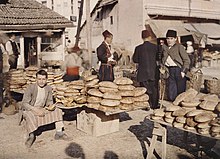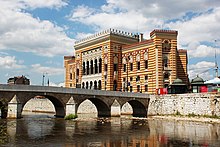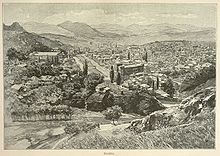Sarajevo
![]()
Sarajevo is a redirect to this article. For other meanings, see Sarajevo (disambiguation).
Sarajevo (Cyrillic Сарајево; German also Sarajewo; pronunciation: [ˈsarajeʋo]) is the capital and seat of government of Bosnia and Herzegovina, the Federation of Bosnia and Herzegovina (Federacija Bosne i Hercegovine/FBiH), and Sarajevo Canton.
The city has 291,422 inhabitants in its four municipalities Stari Grad (Old Town), Centar (Centre), Novi Grad (New Town) and Novo Sarajevo (New Sarajevo). Greater Sarajevo has a population of approximately 555,000 (2013 census). Due to the number of inhabitants and the economic and political importance, Sarajevo is the only Bosnian metropolis.
The south-eastern part of Sarajevo administratively belongs to the city of Istočno Sarajevo in Republika Srpska. According to Article 9 of the RS Constitution, the whole city is also the capital of Republika Srpska, although its seat of government has been in Banja Luka since 1998.
Three events in particular made the city famous worldwide: the assassination attempt in Sarajevo on 28 June 1914, in which Gavrilo Princip assassinated the Austro-Hungarian heir to the throne Franz Ferdinand, the 1984 Winter Olympics and the siege by troops of the Vojska Republike Srpske during the Bosnian War from 1992 to 1995.

View from the east over the city centre
Geography and environment
The city stretches in a west-east direction on the Sarajevo plain in the middle of the Dinaric Mountains. The Miljacka River flows through the city; the Bosna River rises west of the city in the municipality of Ilidža from a karst spring. The plain is overlooked by the mountains of Bjelašnica and Igman to the southwest and Jahorina and Trebević to the southeast.
The city center is 511 meters above sea level. The suburbs reach up to over 900 meters. The mountains around the city are mostly forested and up to 2,000 meters high.
Directly east of Sarajevo is the town of Pale, which was a centre of the Bosnian Serbs during the war from 1992 to 1995.

enlarge and show information about the picture
![]()
280° panorama from Avaz Twist Tower
Climate
The climate in Sarajevo is temperate and slightly continental. The average annual temperature is 9.5 °C; the average annual precipitation is 932 mm. The warmest month is August, the coldest is January. Most precipitation falls in June and November; February is the driest month. Snowfall is possible until April.
The lowest temperature ever measured was -21.8 °C (on 24 January 1963), the highest 37.4 °C (on 24 July 1987).
| Sarajevo | ||||||||||||||||||||||||||||||||||||||||||||||||
| Climate diagram | ||||||||||||||||||||||||||||||||||||||||||||||||
| ||||||||||||||||||||||||||||||||||||||||||||||||
| Monthly average temperatures and precipitation for Sarajevo
Source: wetterkontor.de | ||||||||||||||||||||||||||||||||||||||||||||||||||||||||||||||||||||||||||||||||||||||||||||||||||||||||||||||||||||||||||||||||||||||||||||||||||||||||||||||||||||||||||||||||||||||||||||||||||||||||||||||||||||||||||||||||||||||||||||||||||||||||||||
Air quality
In the winter months, particulate matter levels are regularly up to ten times the EU limits. Sarajevo is one of the world's dirtiest capitals at this time of year, ahead of Beijing, New Delhi and Mumbai. According to the environmental organisation Eko-Akcija, one of the main reasons for this is that many households still use wood and coal for heating, an estimated 35,000 to 40,000. Sarajevo is located in a valley basin from which the smoke can only be removed with difficulty, especially in inversion weather conditions. The smoke then lies over the city for days, which also has health consequences. According to the World Bank, 3,300 people die each year in Bosnia and Herzegovina as a result of air pollution, and according to the European Environment Agency, as many as 5,400.
History
In 1238/39, a Slavic settlement called Vrhbosna was mentioned for the first time in a document of the Croatian-Hungarian King Béla IV in connection with the construction of Saint Peter's Cathedral. From 1463, with the beginning of Ottoman rule under Isa-Beg Ishaković, a Bosnian convert to Islam, the expansion of the town took place. Towards the end of the 15th century, a Turkish governor had set up his domicile on the banks of the Miljacka. A little later, the rapidly flourishing city of Sarajevo was named after this saray (Turkish palace). The Turkish sarây or saray ova is also the name of the seraglio.
In the Ottoman Empire, Sarajevo was the capital of the province of Bosnia since 1850. In 1878, the city was occupied by the Austro-Hungarian Empire along with the entire country.
On 28 June 1914, the city was the scene of the assassination of Archduke Franz Ferdinand and his pregnant wife Sophie, which was one of the main triggers of the First World War. After 1918, Sarajevo became part of the Kingdom of Serbs, Croats and Slovenes along with Bosnia.
During the Second World War, Bosnia was part of the Independent State of Croatia. In Sarajevo, from 1941 to 6 April 1945, Villa Luburić was converted into an internment and execution camp, where hundreds of Serbs and Jews were interned, tortured and murdered by the fascist Ustasha. After the collapse of the Ustasha state and the end of the SecondWorld War, Sarajevo became the capital of the constituent republic of Bosnia and Herzegovina within Yugoslavia in 1945.
One of the most significant events of the Yugoslav era was the 1984 Winter Olympics, which took place in the mountains surrounding the city and brought Sarajevo worldwide attention. After the declaration of independence in the wake of Yugoslavia's disintegration, Sarajevo became the capital of the sovereign state of Bosnia and Herzegovina. Shortly after the declaration of independence, the three-year Bosnian War began.
War in Bosnia
→ Main article: Siege of Sarajevo
During the Bosnian War, Sarajevo was divided into a Bosniak-Croat part controlled by the Government of Bosnia and Herzegovina and a Serb part controlled by the Republika Srpska. The part controlled by government forces, which included the city centre and the Old Town, was besieged for 1,425 days by troops of the then Bosnian Serb army.
The siege of Sarajevo began on 5 April 1992 and was the longest siege in the history of the city. The city centre of Sarajevo was completely surrounded. According to the government of Bosnia and Herzegovina, the siege and the fighting claimed the lives of 10,615 people of all ethnic groups, including 1,601 children. Around 50,000 people were injured, some seriously, by grenades, mines or snipers.
The barracks "Viktor Bubanj" served during the Bosnian war as a military prison of the Bosnian government troops, where civilians were also tortured, abused or killed.

Streets in Sarajevo destroyed during the siege

Market scene in Sarajevo, 1912.

Old City Hall (Vijećnica), later National Library, destroyed during the Bosnian War and renovated until 2014

Historical city view of Sarajevo around 1900
Search within the encyclopedia